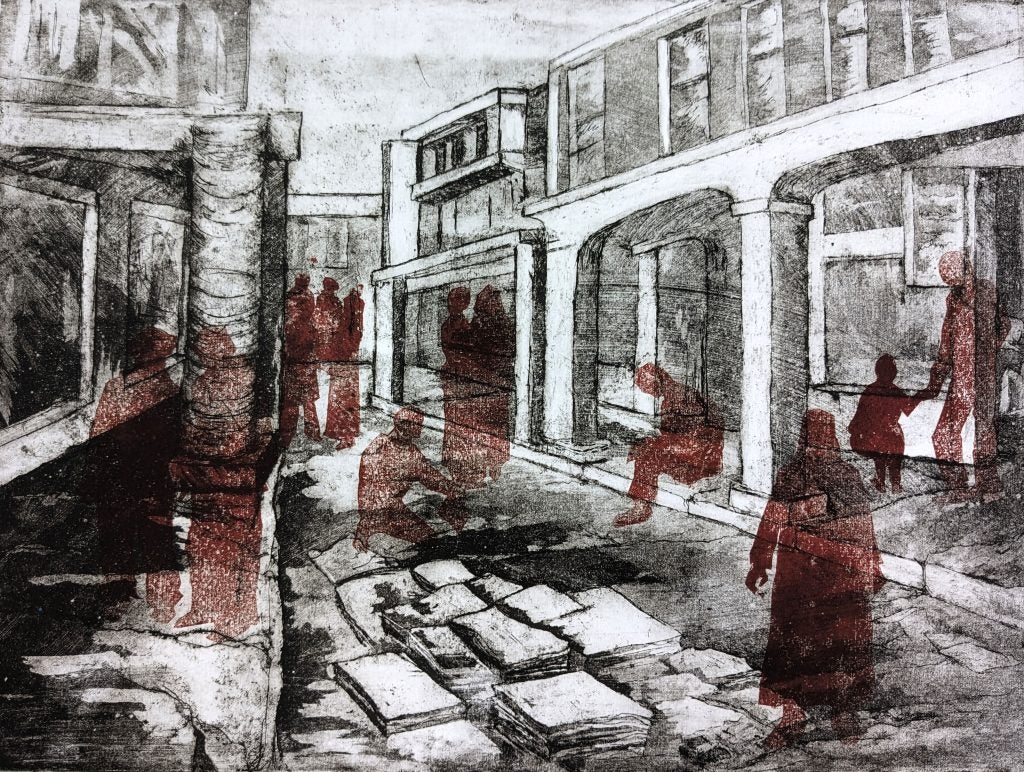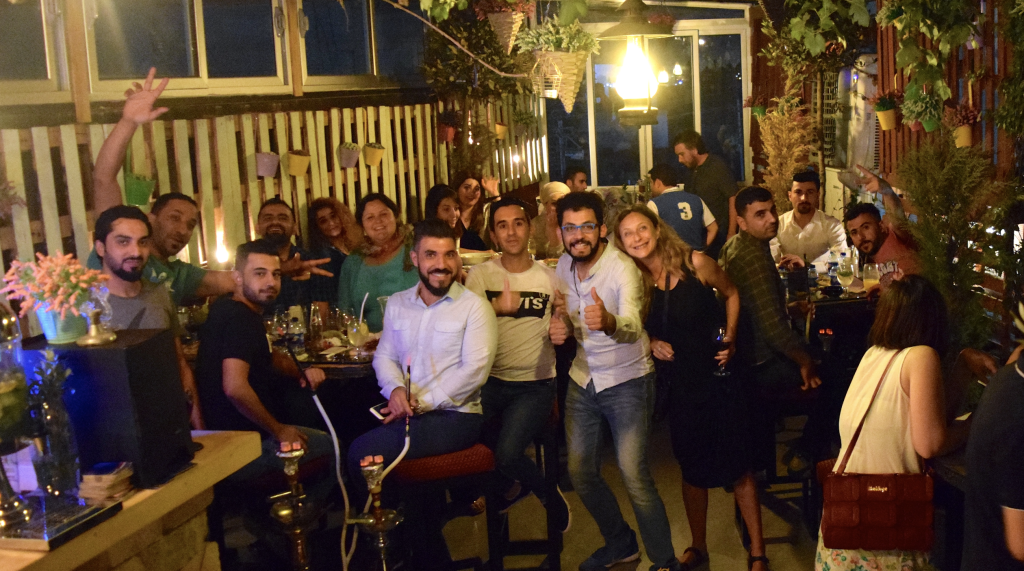
Over pizza in the charming town of Ankawa on the outskirts of Erbil, Iraq, survey field researchers start telling their stories from the field. “I’m visiting this one house, and I come to the question about ‘do you consider yourself displaced,’” recounts a veteran Iraqi researcher. “The hajji [elderly man] stares at me silently for a minute, and then with a deadpan expression on his face says, ‘Do I consider myself displaced? No, I consider myself a lawyer!’ He then angrily yells at us to get out.”
The table erupts in laughter. The casual outing in summer of 2018 had been proceeded by a week’s worth of training workshops on survey and interview best practices, discussions on questionnaires, and logistical meetings in a stuffy, high-rise hotel on Erbil’s 60 Meter Street. Research teams from Georgetown University (GU) and from the International Organization for Migration (IOM) were gathered in preparation for the latest round of qualitative and quantitative data collection for the joint project Access to Durable Solutions Among Internally Displaced Persons (IDPs) in Iraq.
The first-ever study of its kind, Access to Durable Solutions Among IDPs in Iraq followed, over a five-year period, nearly 3,600 Iraqi households that had been displaced by ISIS/ISIL. In this one evening away from official formalities, what crystalizes among the GU and IOM teams is that the study’s substantive contributions and innovations stem from the strengths of this academic-NGO partnership.
In addition to contributing to the study’s methodological rigor, GU’s participation ensured that the research was not an extractive process of collecting data on a given population in service of knowledge creation. The GU team used all resources at its disposal—including input on budget allocation and the team’s status as educators—to ensure that both the IDP households themselves and the Iraqi research teams benefitted from the study. As such, the partnership reaffirmed that the transfer of knowledge, skills, and benefit from participation in research need not be unidirectional.
The commitment of IOM’s research leadership to the project ensured not only continuity of material resources to sustain it, but more importantly, knowledge of the intersection between IDPs’ self-reported challenges and proposed humanitarian policy solutions and initiatives. IOM field researchers and local staff provided invaluable feedback on questionnaires and new policies and laws that affected the study and its trajectory.
Six rounds of surveys and qualitative interviews with the same IDP households between 2016 and 2021 sought to assess how, when, and if Iraqi IDPs were reaching one of three, “solutions” to their displacement: voluntary return home, local integration, or resettlement to another country or location. Determination of whether these solutions were achieved were based on eight criteria outlined by the Inter Agency Standing Committee’s (IASC) Framework on Durable Solutions for Internally Displaced Persons: safety and security, standard of living, livelihood, housing, access to documentation, family reunification, participation in public affairs, and access to justice.
Of the many findings the study unearthed in these numerous reports, perhaps the most important was to highlight the need for the IASC Framework to be more deliberate and explicit in its accounting for IDP preferences in what they considered the “end” of displacement. The answer to the question “when does displacement end?” for some was simply, “it doesn’t.” As such, the “end” of displacement should not be thought of in terms of an arrival point or a solution but instead of an ever-evolving process of access and belonging.
“Do you consider yourself displaced?” was a key question leading to this finding. Its purpose was to give voice to IDPs’ self-perceptions and compare them against standardized indicators measuring attainment of a “durable solution,” defined by the IASC Framework as being achieved, “when IDPs no longer have specific assistance and protection needs that are linked to their displacement and such persons can enjoy their human rights without discrimination resulting from their displacement.”* While many of the Iraqi IDP households represented by the study had met benchmarks of a “solution,” by the final round of data collection in 2021, more than half of all IDP households living in displacement indicated they still considered themselves displaced.
The five-year study yielded six summary reports on the experience of protracted displacement; five thematic and policy reports on topics such as livelihoods and economic security and experiences of female-headed houses; and three academic papers investigating education in displacement and experiences of return. Findings from the study were publicly disseminated at numerous presentations for audiences variously gathered in front of the International Forum on Migration Statistics, Mercy Corps, the Gulf International Forum, the World Bank, IOM-Iraq, and the University of Kurdistan, among others.

Making such deliverables feasible required the herculean efforts of a large team. Lorenza Rossi, IOM’s Regional Data Hub and DTM Coordinator, conceived of the project and CCAS Professor Rochelle Davis, shepherded it for its duration. ISIM professors Susan Martin, Elizabeth Ferris and Katharine Donato, CCAS and ISIM staff members Abbie Taylor, Grace Benton, Dana Al Dairani, and Vicki Valosik, and IOM-Iraq’s Olga Aymerich, Erin Neale, Shano Mohammed, Mazn Shkoor, and more than 25 Iraqi field researchers pooled collective talents to keep the behemoth study in motion. This core group conceived of topics and populations to include, wrote interview questions, programmed software, gained necessary legal access letters, oversaw fieldwork and conducted interviews, authored reports, and organized events and disseminated findings online and in print. Teams of GU student research assistants painstakingly translated interviews, coded qualitative excerpts, cleaned data, and conducted literature reviews and secondary research. In Dr. Davis’ courses over the years, undergraduate and graduate students were encouraged to learn how to use the qualitative and quantitative data for research papers and projects.
In the field, despite the question of whether respondents considered themselves displaced being met with resistance if not ridicule, IOM’s team of Iraqi field researchers became the mediators of researchers’ intention and respondents’ understanding. Training workshops and handbooks the GU team ran and authored over the years became key pieces of capacity building intended to hone interviewer skills and enable future employment. The hope was that those facilitating the study could be better equipped to handle challenges on both this project and others.The workshops and handbooks discussed strengths and tradeoffs of quantitative and qualitative data; how to write questions; respondent selection considerations; and best field interview practices in conducting both surveys and qualitative interviews. The interviewer team became one that IOM subsequently employed in other projects. At the same time, the feedback of the interviewers on the wording and content of the questions alerted the research team to key themes that were conspicuously absent or sensitives that were obscuring results.
This capacity development component of the study complemented a second distinguishing feature: the largest line item in the budget of the project was an in-kind payment of monthly mobile phone credits to the IDP households who remained in the study. IOM Iraq’s field researchers used the TextIt System, a text messaging platform, to maintain monthly contact with IDP families participating in the study and to verify and update their locations as they moved around in Iraq.
What also became increasingly clear over the course of the project was that the study’s results—and indeed the data itself—needed to be more widely distributed and accessible. In service of this goal, the team translated many reports and findings into Arabic so that they could be accessed by a wider range of people affected by—and endowed with power to affect—displacement-related policies. More significantly, the GU-IOM partnership concluded by creating a website where not only the published reports, but also the methodology, questionnaires, and merged panel dataset (combining rounds one through five of the study) are all publicly available for download and use.*
At the inception of the study in 2015, IOM Iraq reported that there were approximately 3.3 million IDPs in the country. Today, the IDP population stands at just under 1.2 million. These numbers, however, are calculated using the internationally recognized and codified standards of “counting” IDPs. If the IASC Framework suggests that most of Iraq’s IDPs have, over the years, found a solution to their displacement, Access to Durable Solutions Among IDPs in Iraq should serve as a reminder that it is equally important to take into account how IDPs see themselves; or in other words, to remember not only what the Framework tells us about the end of displacement in Iraq, but what Iraq tells us about the end of displacement.
*See also https://ccas.georgetown.edu/resources/iom-gu-iraq-idp-study/ to read the IASC Framework and summary reports.
Salma Al-Shami is Director of Research at Arab Barometer, a non-resident visiting scholar at CCAS, and an adjunct professor in the Global Human Development Program. She served as the chief data analyst for Access to Durable Solutions Among Internally Displaced Persons (IDPs) in Iraq.
This article was originally published in the Spring/Summer 2023 CCAS Newsmagazine.